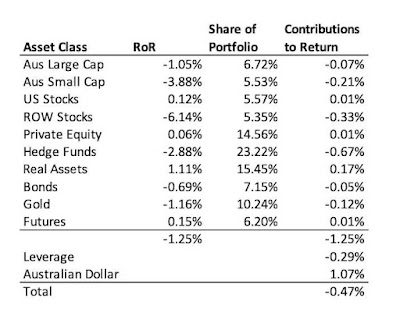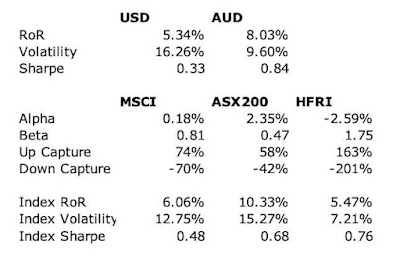For the last six years I've been putting together reports on our spending over the Australian financial year, which runs from 1 July to 30 June. This makes it easy to do a break down of gross income including taxes that's comparable to many you'll see online, though all our numbers are in Australian Dollars. At the top level we can break down total income (as reported in our tax returns plus superannuation contributions) into the following categories of spending:

The gross income for this year (bottom line) is just an estimate. It is based on the gross income we expect to report in our tax returns (before investment expenses etc) plus employer superannuation contributions. Tax includes local property tax as well as income tax and tax on superannuation contributions. Investing costs include margin interest. Mortgage interest is included in spending, while mortgage principal payments are considered as saving. Spending also includes the insurance premia paid through our superannuation. Current saving is then what is left over. This is much bigger than saving out of salaries because gross income includes investment returns reported in our tax returns. The latter number depends on capital gains reported for tax purposes, so is fairly arbitrary. Spending increased substantially, though we also expect income to hit a high though it's been fairly constant over the last five years. Graphically, it looks like this:

We break down spending into quite detailed categories. Some of these are then aggregated up into broader categories:
Our biggest spending category, if we don't count tax, is now childcare and education, which has now fallen for two years in a row. Shifting from daycare, to private per-K, to private junior school actually reduces costs! We also include things like swimming and piano lessons in this category. Commentary on other categories follows:
Employer superannuation contributions: These include employer contributions (we don't do any salary sacrifice contributions) but not contributions we paid to the SMSF this year.
Franking credits: Income reported on our tax returns includes franking credits (tax paid by companies we invest in). We need to deduct this money which we don't receive as cash but is included in gross income. Effectively, this is tax paid on our behalf by corporations that we are shareholders of. Foreign tax paid is the same story.
Superannuation contributions tax: The 15% tax on concessional
superannuation contributions. This includes tax on our concessional
contributions to the SMSF.
Life and disability insurance: This is paid out of our contributions to our employr superannuation funds. I have been trying to bring this under control and the amount paid has also fallen since 2017-18 a result.
Health: Includes health insurance and direct spending. These increased by 12% and 10%, respectively. Spending peaked with the birth of our second child.
Housing: Includes mortgage interest, maintenance, and body corporate fees (condo association). This category fell by 27% this year, due to us paying less in mortgage interest. This is the reason that our total spending is down this year.
Transport: About two thirds is spending on our car and one third is my spending on Uber, e-scooters, buses etc.
Utilities: This includes water, gas, electricity, telephone, internet, and online storage etc.
Subscriptions: This is a new category this year, split out from utilities. Spending has been stable in the last three years after rising during the pandemic.
Supermarkets: Includes convenience stores, liquor stores etc as well as supermarkets. This has now been stable for the last four years.
Restaurants: This was low in 2017-18 because we spent a lot of cash at restaurants. It was low during the pandemic for obvious reasons but has been back to pre-pandemic levels in the last three years. We also spent a lot on restaurants in cash while on vacation in China and Thailand.
Cash spending: I try not to use cash so that I can track spending. Moominmama also gets some cash out at supermarkets that is included in that category. Spending jumped 20-fold this year due to spending in cash while traveling in Asia.
Department stores: All other stores selling goods that aren't supermarkets. No real trend here.
Mail order: This has continued to fall. Moominmama now gets mail order direct from China that doesn't enter into our accounting system. When we were in China we deposited RMB cash in her mother's bank account. I treated this in our accounts as a repayment of a loan from her mother. Evidently the money is being used to buy stuff in China...
Travel: This includes flights, hotels etc. It has now been back at pre-pandemic levels for the last two years.
Charity: Increased a little bit. We pay one charity on a regular basis but otherwise I just respond to requests I get.
Professional: These are work expenses that were not paid for directly by our employers. So, we got reimbursement for some of these, but that reimbursement is not in our income number. Really, our savings were larger by the value of that reimbursement (about $2k this year).
Other: This is mostly other services. It includes everything from haircuts to professional photography.
In summary, our spending fell due to reduced mortgage interest payments. In the accounts I post at the end of the calendar year, that interest is accounted for as an investment expense. Spending apart from mortgage interest was up a little.

























